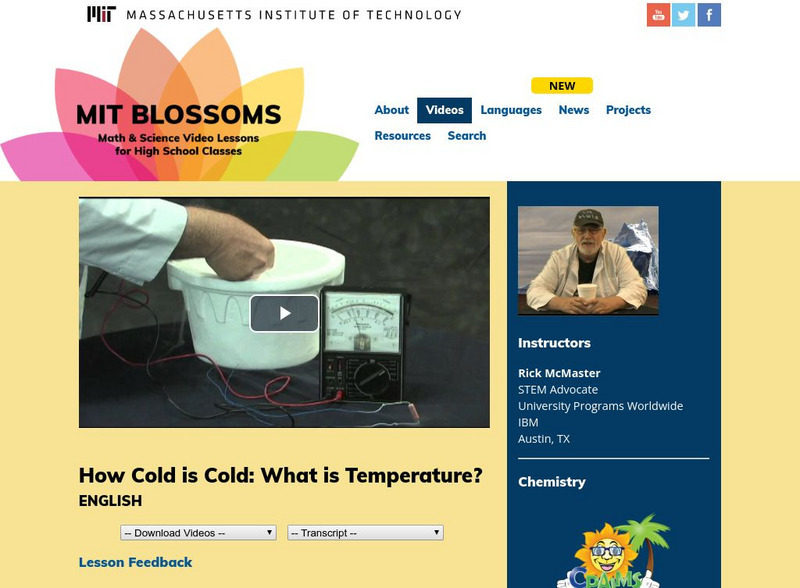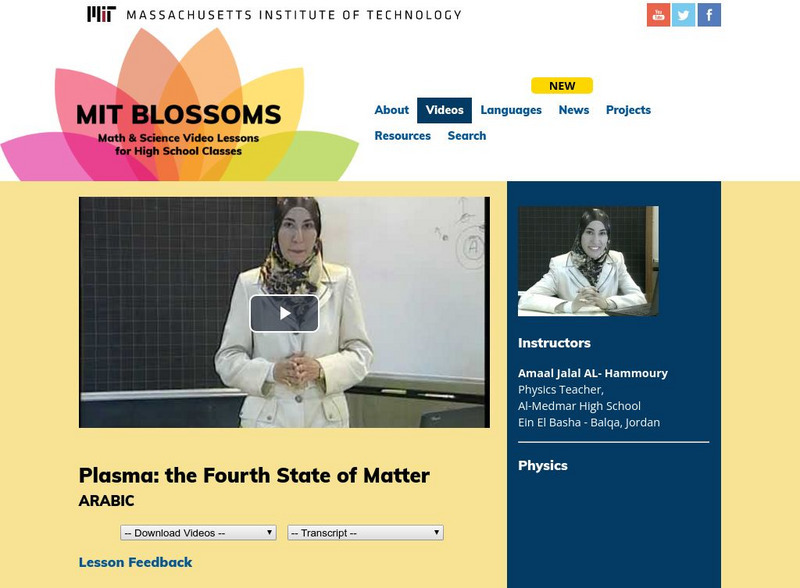Hi, what do you want to do?
Massachusetts Institute of Technology
Mit: Blossoms: Free Fall
This video lesson is an example of "teaching for understanding" in lieu of providing students with formulas for determining the height of a dropped (or projected) object at any time during its fall. The concept presented here of creating...
Massachusetts Institute of Technology
Mit: Blossoms: Psychology to Logic: Learning Computer Programming in the Kitchen
This lesson focuses on the biggest problem faced by any young programmer, the logic building required while solving a particular problem.[28:25]
Massachusetts Institute of Technology
Mit: Blossoms: Galaxies and Dark Matter
This video lesson has the goal of introducing students to galaxies as large collections of gravitationally bound stars. It explores the amount of matter needed for a star to remain bound and then brings in the idea of Dark Matter, a new...
Massachusetts Institute of Technology
Mit: Blossoms: Geologic Time: The Ticking of Our Planet's 4.6 Billion Year Clock
This BLOSSOMS lesson will help students conceptualize the enormity of geologic time and learn about important events in Earth's history. Students will also learn how geologic time can help explain seemingly incomprehensible processes....
Massachusetts Institute of Technology
Mit: Blossoms: Gravity Assist Stealing a Planet's Angular Momentum
This video lesson will present Gravity Assist, or what is wrongly referred to as the gravitational slingshot. Gravity assist is a maneuver performed by interplanetary spacecraft to travel farther on less fuel. It is a classic exercise in...
Massachusetts Institute of Technology
Mit: Blossoms: Gravity at Work
This video lesson highlights how science can be learned from daily life experiences. It emphasizes the ways in which simple laws of physics can be understood from personal observations and experiences, and in fact it demonstrates that we...
Massachusetts Institute of Technology
Mit: Blossoms: How Big Is a Mole? Do We Really Comprehend Avogadro's Number?
The goal of this lesson is for students to understand just how many particles Avogadro's Number truly represents, or, how big a mole really is. [19:02]
Massachusetts Institute of Technology
Mit: Blossoms: How Cold Is Cold: Properties of Materials at Lower Temperatures
This video is the second lesson in the How Cold Is Cold? BLOSSOMS series and examines the properties of materials under low temperature conditions. [32:19]
Massachusetts Institute of Technology
Mit: Blossoms: How Cold Is Cold: What Is Temperature?
This video lesson is part of a two-part series and introduces the concept of temperature. Temperature can be a challenging concept to convey since our perception is tied to words that are relative to our own experience, which varies...
Massachusetts Institute of Technology
Mit: Blossoms: How Does Biotechnology Help Clean Up the Environment?
The objective of this lesson is to introduce students to one of the most important issues affecting human life and health in the 21st century, the application of modern biotechnology to the problems of environmental pollution. [22:51]...
Massachusetts Institute of Technology
Mit: Blossoms: How Much Small Is Small?
This video lesson introduces students to the concept of size. It looks at how to classify objects based on their size and how the size of an object affects its properties and behavior. In our world, we have many different sizes -...
Massachusetts Institute of Technology
Mit: Blossoms: Is Bigger Better? A Look at a Selection Bias That Is All Around Us
This learning video addresses a particular problem of selection bias, a statistical bias in which there is an error in choosing the individuals or groups to make broader inferences. Rather than delve into this broad topic via formal...
Massachusetts Institute of Technology
Mit: Blossoms: Computer Network Topologies & Malaysian Weddings
The aim of this video lesson is to teach students about the different topologies of computer networks and how they function. The approach that is used is highly correlated with common knowledge about weddings and the local Malay culture...
Massachusetts Institute of Technology
Mit: Blossoms: Kite Flying: Fun, Art and Science
This lesson presents the basics of aerodynamics by using kite flying as an example, i.e., forces acting on a flying object. [39:36]
Massachusetts Institute of Technology
Mit: Blossoms: Measuring Distances in the Milky Way
The main aim of this lesson is to show students that distances may be determined without a meter stick-a concept fundamental to such measurements in astronomy. It introduces students to the main concepts behind the first rung of what...
Massachusetts Institute of Technology
Mit: Blossoms: Methods for Protein Purification
This Protein Purification video lesson is intended to give students some insight into the process and tools that scientists and engineers use to explore proteins. It is designed to extend the knowledge of students who are already...
Massachusetts Institute of Technology
Mit: Blossoms: Optimizing Your Diet: What Linear Programming Can Tell You!
In this video lesson, students will learn about linear programming (LP) and will solve an LP problem using the graphical method. Its focus is on the famous "Stigler's diet" problem posed by the 1982 Nobel Laureate in economics, George...
Massachusetts Institute of Technology
Mit: Blossoms: Physics of Donkey Carts
This video lesson explores Newton's Third Law of Motion through examination of several real world examples of this law in action, including that of a donkey cart - a site common in the streets of Pakistan. Students will understand that...
Massachusetts Institute of Technology
Mit: Blossoms: Plants and Environmental Resources
Earth contains a variety of plants to provide food, medicine and, most importantly, energy sources for humans. In this lesson, students will categorize plants by their components and shapes. Additionally, they will learn the mechanisms...
Massachusetts Institute of Technology
Mit: Blossoms: Plasma: The Fourth State of Matter
In this video lesson, students will achieve the following learning objectives: 1) Become familiar with the fourth state of matter, "plasma"; 2) Understand the concept of plasma: 3) Compare the four states of matter; and 4) Learn some...
Massachusetts Institute of Technology
Mit: Blossoms: Pythagoras and the Juice Seller
This video lesson presents a real world problem, one that a juice seller faces daily, that can be solved by using the Pythagorean theorem. [33:54]
Massachusetts Institute of Technology
Mit: Blossoms: Quantifying the Energy Associated With Everyday Things and Events
This lesson is about energy and how it manifests itself in every day things and events. In particular, the video focuses on quantification or estimation of energy. The main learning objectives are to: gain familiarity with units of...
Massachusetts Institute of Technology
Mit: Blossoms: Rational Versus Irrational Numbers
The scope of this video lesson consists in studying the sets of Rational and Irrational numbers. The main objectives for the students are: 1) Learning how to distinguish between a rational number and an irrational number; 2) Learning...
Massachusetts Institute of Technology
Mit: Blossoms: Roots, Shoots, and Wood
The topic of photosynthesis is a fundamental concept in biology, chemistry, and earth science. Educational studies have found that despite classroom presentations, most students retain their naive idea that a plant's mass is mostly...




























